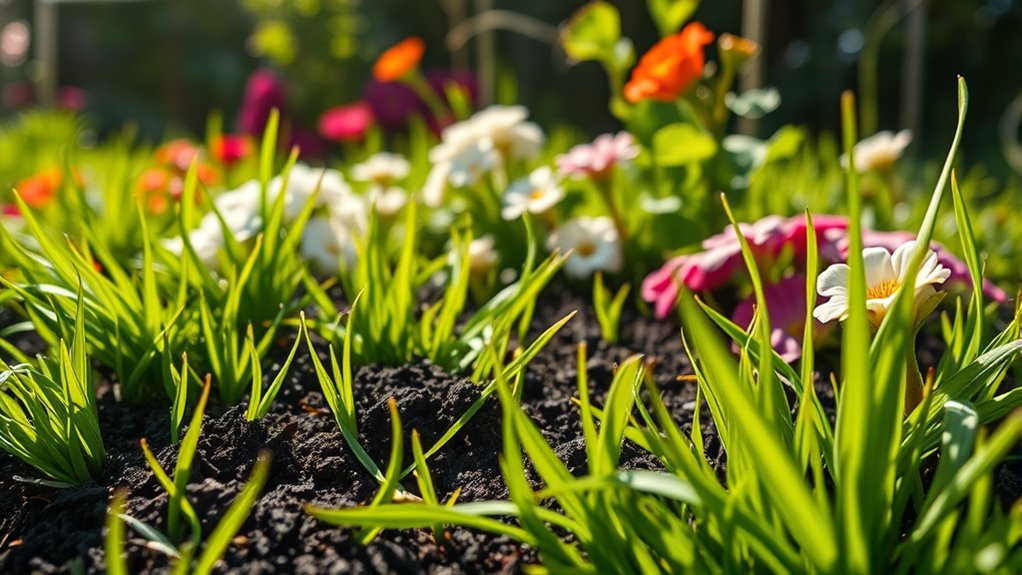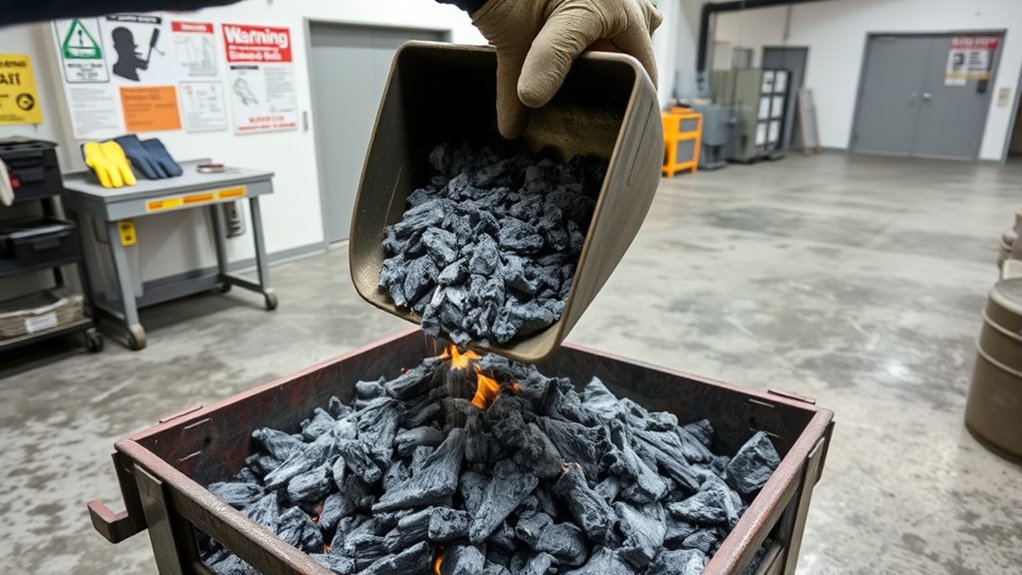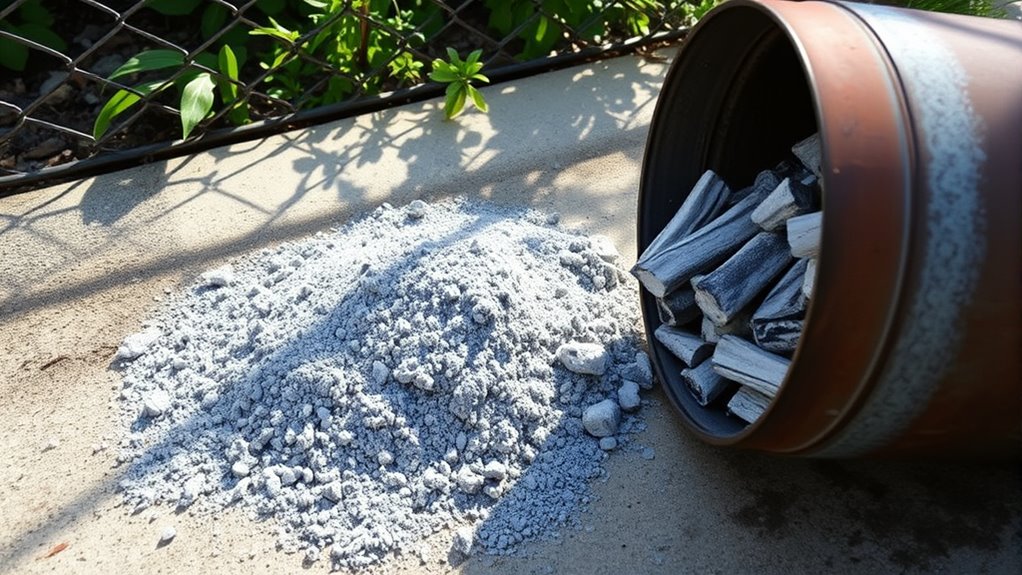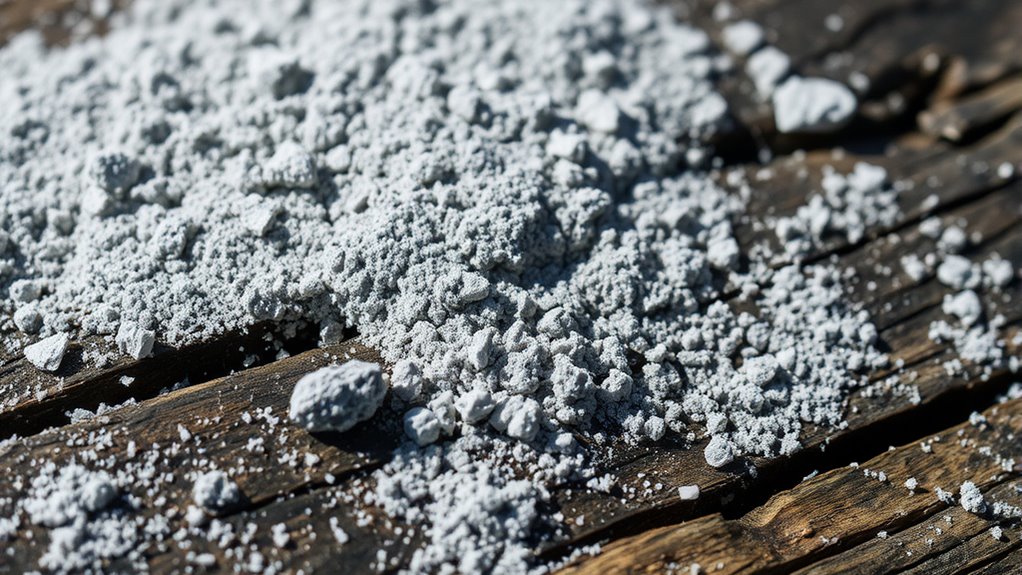To handle wood ashes safely, store cooled ashes in fire-resistant metal containers away from ignition sources, and wait at least 24 hours before disposal. You can use ashes as a soil amendment or fertilizer by spreading a thin layer around plants or mixing them into compost, but be cautious of their high alkalinity. For winter traction, spread cooled ashes evenly on walkways and driveways. To discover more tips on responsible disposal and creative uses, keep exploring this guide.
Key Takeaways
- Allow ashes to cool completely before handling or disposal to prevent fire hazards.
- Store cooled ashes in fire-resistant, sealed containers away from ignition sources.
- Use ashes as a soil amendment or fertilizer, applying in thin layers and mixing into compost.
- Spread ashes evenly on lawns or garden beds, avoiding sensitive plants, and water lightly afterward.
- Follow local regulations for disposal, avoiding dispersing ashes near water bodies or natural ecosystems.
Safe Storage of Ashes

Have you ever wondered how to store ashes safely? Proper ash storage is essential for fire safety. Always place cooled ashes in a metal container, preferably galvanized or sealed, with a tight-fitting lid. This prevents wind dispersal and keeps sparks or embers from igniting nearby materials. Elevate the container on a concrete block or similar surface to reduce the risk of igniting weeds or combustible debris underneath. Never transfer hot ashes directly from the fire to your storage container, as this can cause accidental fires. Keep the container away from ignition sources like open flames, dry brush, or other combustibles. Regularly check and clean the container to prevent buildup and ensure it remains fire-resistant. Additionally, using fire-resistant containers significantly enhances safety. Properly disposing of ashes after use is also crucial to prevent residual embers from reigniting. Incorporating fire safety practices when handling and storing ashes helps keep your environment safe from ash-related fires. To further reduce risks, consider using ash disposal methods recommended by fire safety experts. Maintaining awareness of proper storage techniques can further minimize fire hazards associated with ashes.
Using Ashes as Fertilizer and Soil Amendment

Wood ashes can serve as a valuable natural fertilizer and soil amendment because they are rich in potassium, calcium, and trace minerals. When used appropriately, ashes provide essential nutrients that enhance soil enrichment and support plant growth. They are particularly effective in raising pH levels, making soils more alkaline. Use a thin layer of cooled wood ashes around garden beds for gradual soil amendment and improved structure. Incorporating ashes into compost can help balance pH and accelerate organic matter decomposition. Proper application helps prevent soil alkalinity issues that could harm acid-loving plants like blueberries and rhododendrons. Properly managed, wood ashes can be a beneficial fertilizer, supporting soil health without causing harm. Additionally, understanding soil pH adjustment can help optimize the benefits of using ashes in your garden. Considering nutrient imbalances can further enhance soil fertility and plant health when applying ashes. Being aware of soil testing can guide you in applying ashes more effectively and avoiding over-application. Using application guidelines ensures you maximize benefits while minimizing potential drawbacks.
Dispersing Ashes on Lawns and Garden Beds

When dispersing wood ashes on your lawn or garden beds, make sure to spread them thinly and evenly to avoid over-alkalizing the soil. Lightly water the area afterward to help the ashes incorporate smoothly and stay in place. Keep in mind that some plants, like blueberries, prefer less alkaline conditions, so avoid applying ashes near them. Monitoring soil pH levels can help ensure optimal plant health. Additionally, considering the market growth in AI technology can provide insights into advanced soil testing tools that enhance gardening efficiency. Incorporating nutrient balance assessments can further optimize the benefits of ash application and promote healthy plant growth. Regularly testing soil nutrient levels can help you better understand how ashes influence overall soil health and plant development.
Proper Application Techniques
To guarantee your ashes benefit your garden without causing harm, you need proper application techniques. Start by spreading cooled ashes in a thin layer across your garden beds or lawns, ensuring even distribution. This helps supply essential soil nutrients like potassium without raising soil pH too quickly. Apply ashes during early winter or on damp evenings to promote natural absorption and reduce wind dispersal. To cover large areas, mix ashes with water for a more uniform spread and prevent clumping. Use a rake or garden tool to evenly disperse the ashes around plants, avoiding thick piles that could damage roots. After application, cover the ashes with soil or mulch to stabilize them, prevent wind blow-off, and seamlessly incorporate nutrients into the soil. Additionally, understanding the horsepower of electric dirt bikes can help you appreciate the energy efficiency and power behind electric tools used for garden maintenance. Properly managing the self watering plant pots can also assist in maintaining moisture levels for newly amended soil, especially when combined with watering techniques to optimize plant health. Incorporating soil testing before and after ash application can ensure you maintain the correct pH balance and nutrient levels to support healthy plant growth.
Soil and Plant Compatibility
Dispersing ashes on lawns and garden beds requires careful attention to soil and plant compatibility. Ashes are highly alkaline, with a pH between 9 and 11, which can raise soil pH and benefit acid-loving plants. However, they may harm plants sensitive to alkalinity like blueberries or rhododendrons. Use ashes sparingly, spreading a thin, even layer during early winter or damp evenings. Incorporating ashes into compost helps buffer pH and supply trace minerals, supporting healthy soil and plant growth. testing soil pH can help determine the appropriate application rates for different plants. Before spreading, ensure ashes are fully cooled to prevent plant damage or fires. Understanding your soil’s current pH and plant needs is essential for safe, effective use. Additionally, understanding soil amendments can improve the overall health and balance of your garden ecosystem. Applying ashes with proper techniques minimizes environmental impact and enhances soil quality. Recognizing the WWE Raw’s financial impact can also inform how we value and manage resources in entertainment and agriculture alike. Incorporating ash analysis can further optimize how ashes are used within different garden settings.
Making Use of Ashes for Traction During Winter

Using ashes for traction can boost safety on icy surfaces, but it’s important to do so safely. Applying a thin, even layer before snow falls helps prevent ice buildup and improves grip. Always store cooled ashes properly to avoid fire risks and reapply as needed for continuous traction. To ensure safe and effective use, consider the proper handling of ashes, which includes understanding their properties and safe storage practices. Additionally, understanding the nutritional benefits of fats, such as those found in coconut oil, can inform better choices for energy sources if considering alternative uses for ashes or related materials. Regularly cleaning and maintaining your pet hair management tools can also prevent the spread of debris, including ashes, in your environment. Proper disposal and understanding of fire safety practices are crucial when working with ashes to prevent accidents.
Applying Ashes Safely
Applying ashes safely during winter starts with spreading cooled wood ashes sparingly on icy driveways and walkways to enhance traction. To do this effectively:
- Store ashes in a metal container until fully cooled, preventing fires or odors.
- Distribute ashes evenly across surfaces, avoiding thick layers that can become slippery or damage pavement.
- Apply ashes before snow or rain forecasted, helping them absorb moisture and maintain grip longer.
- Replenish ashes periodically during winter storms to ensure continuous winter traction.
Enhancing Winter Traction
Have you considered how cooled wood ash can enhance your winter safety? Spreading wood ash evenly on icy driveways and walkways improves winter traction, reducing slips and falls. Apply a thin layer of ash before a forecasted snowstorm; it helps snow melt faster and prevents ice buildup. Use ash sparingly on steps and slopes to increase grip without creating excessive alkalinity or safety concerns. Disperse ashes over snowbanks and icy patches for a natural, eco-friendly traction aid that minimizes environmental impact. Remember to store ashes in a metal container and let them cool completely before spreading, preventing accidental fires or burns. Incorporating ash spreading into your winter safety routine offers an effective, sustainable way to stay secure during icy conditions.
Incorporating Ashes Into Compost Piles

Incorporating ashes into your compost pile can boost soil fertility by adding essential potassium, but it’s important to do so carefully.
- Use cooled wood ashes, mixing them in small, thin layers to prevent excess alkalinity.
- Keep ashes to no more than 10% of your compost volume to avoid pH imbalance.
- Incorporate ashes gradually to support nutrient recycling and maintain ideal microbial activity.
- Make certain ashes are fully cooled before mixing to prevent fires or damaging microorganisms.
Creative Crafts and Artistic Uses of Ashes

Ashes offer a versatile material for creative projects, allowing you to craft unique art pieces and decorative items with natural, earthy appeal. You can mix ashes into ceramic glazes to create textured finishes with a rustic look, adding depth to your pottery. Incorporate ashes into plaster or concrete to shape artistic sculptures or figurines that showcase their natural grain. For eco-friendly paper, blend ashes into pulp, producing textured, recycled sheets perfect for handmade cards or artwork. Use ashes as natural pigments to add muted gray or black tones to your paintings, giving your art an organic touch. Additionally, you can craft DIY crafts like garden markers or ornaments by embedding ashes into resin or clay, turning waste into meaningful, artistic expressions.
Environmental Considerations for Ash Disposal

Disposing of ashes responsibly is essential to protect the environment. Proper ash management helps maintain environmental safety and prevents harm to water bodies and soil. Here are key considerations:
- Avoid dispersing ashes near water bodies or wetlands to prevent increasing alkalinity that can harm aquatic ecosystems.
- Ensure ashes are fully cooled and stored in fire-resistant containers to reduce fire hazards and contamination risks.
- Use ashes as soil amendments cautiously, as their high pH (9-11) can raise soil alkalinity and impact plant health if over-applied.
- Limit ash application in natural settings to avoid disrupting soil microbial activity and damaging local ecosystems.
Handling and Disposal Safety Tips

Handling and disposing of ashes safely is essential to prevent fires and environmental hazards. Always wait until ashes are completely cooled, which usually takes at least 24 hours, before handling or disposal. This prevents accidental ignition and burns. Store cooled ashes in a fire-resistant, metal container with a secure lid to minimize the risk of fires from wind or accidental contact. Never dispose of ashes directly on combustible materials, dry brush, or near open flames. Instead, spread ashes thinly on soil, lawns, or garden beds, ensuring they are fully cooled to avoid environmental harm. Follow local regulations and environmental guidelines for disposal, including using designated trash bins or approved disposal areas. Proper safety measures protect you and the environment from potential hazards.
Local Regulations and Disposal Locations

To guarantee safe and compliant disposal of wood waste, it’s important to familiarize yourself with your local regulations and disposal sites. Many areas require ashes to be fully cooled before ash disposal to prevent fire hazards. Check with your waste management authorities for specific guidelines. Some municipalities designate disposal sites or drop-off facilities at landfills or recycling centers for ash collection. Be aware that dumping ashes in water bodies or on public land is usually prohibited to protect environmental safety. Instead, consider spreading cooled ashes in designated yard waste areas or using them as soil amendments in approved locations. Always verify local regulations to ensure proper disposal and avoid contamination. Following these rules helps keep waste management responsible and environmentally safe.
Frequently Asked Questions
What Is the Best Way to Dispose of Firewood Ashes?
When asking about the best way to dispose of firewood ashes, you should first verify they’re completely cooled. Store them in a metal container, then either spread thinly on your garden beds to enrich the soil or dump them in a designated waste area or trash bin. Avoid dumping ashes in water and never dispose of hot ashes, as they pose fire risks. Using cooled ashes wisely helps maintain safety and promotes soil health.
How to Get Rid of Large Amounts of Ash?
Getting rid of large amounts of ash is like managing a mountain of snow—you need proper tools and methods. First, let the ashes cool completely in a metal container. Then, transfer them into fire-resistant containers, spreading them out to prevent overfilling. You can reuse ashes in your garden or for traction on icy surfaces. Regularly clean storage areas to stay safe and prevent fire hazards.
Is It OK to Throw Away Ashes?
Yes, you can throw away ashes, but only if they’re completely cooled and extinguished. Never toss hot ashes into the trash, as they can cause fires or ignite nearby materials. Store cooled ashes in a sealed, fire-resistant container until you’re ready to dispose of them safely. Always follow local regulations to guarantee proper disposal and protect the environment from potential hazards.
How to Get Rid of a Pile of Ashes?
When you’re ready to get rid of a pile of ashes, first verify they’re completely cooled for at least 24 hours. Then, transfer them to a metal, fire-resistant container with a tight lid. Spread the ashes thinly in your outdoor trash bin, mixing with soil or water to prevent wind dispersal and reduce alkalinity. Never dump ashes directly into water or on dry, combustible materials to stay safe and eco-friendly.
Conclusion
Now that you know how to safely store, skilfully spread, and sustainably dispose of ashes, you can confidently convert waste into wonder. Embrace eco-friendly efforts by exploring creative crafts, cultivating crops, and caring for the climate. With mindful methods and municipal measures, you turn ashes from ash heap to helpful habitat. Harness helpful hints, heed health tips, and happily harness nature’s humble, healing ashes for a greener, greater garden and globe.











